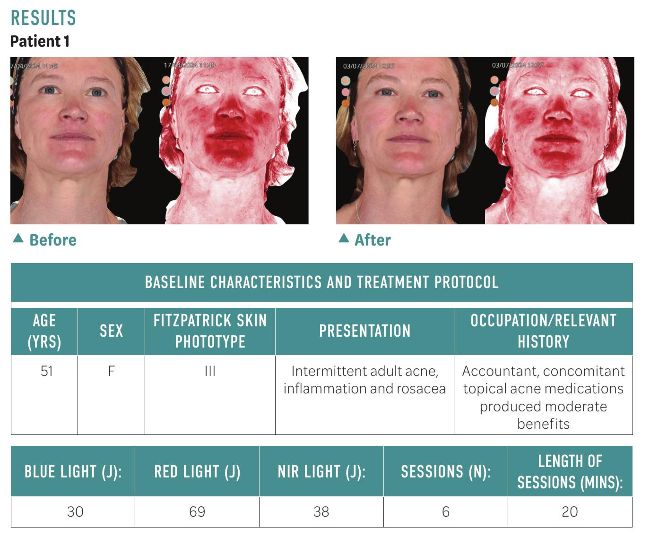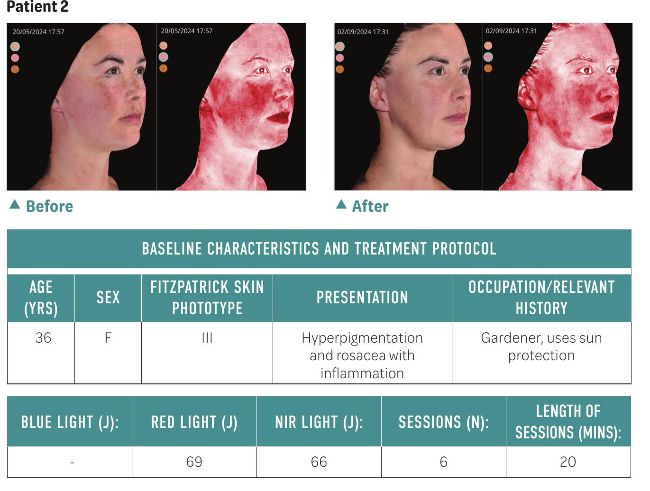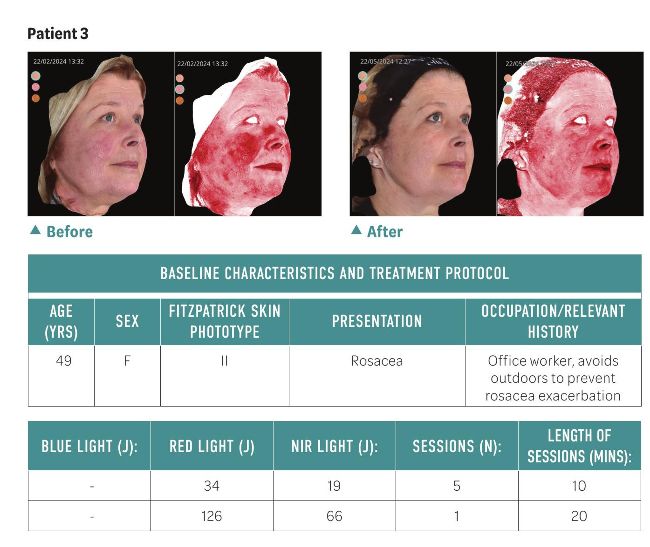ROSACEA MANAGEMENT
LED light therapy in rosacea management
Dr Ian Strawford shares a case series review, outlining the efficacy of combination LED light therapy in rosacea management
Rosacea is a chronic inflammatory skin disease affecting one in 20 patients in the UK.1 It is known for being a challenging skin condition to treat, disproportionally impacting women.
Light-emitting diode (LED) light therapy has demonstrated promising results in the treatment of inflammatory skin conditions, such as acne and psoriasis, by reducing inflammation and promoting skin healing.2,3,4
This case evaluates the therapeutic outcomes of using Dermalux’s Tri-Wave MD LED light therapy device in four patients with rosacea, exploring the efficacy of blue (415nm), red (633 nm) and near-infrared (NIR) (830nm) LED light combination phototherapy.
Cosmetic expert Dr Strawford outlines how to treat rosacea, by first reviewing the root cause.
“We know that rosacea is caused by a dysfunction of pilosebaceous units in the skin. For patients with rosacea, these pilosebaceous units don’t allow oil to be secreted effectively. When the sebum is trapped, microbes will often go into the skin to feed on the oil, releasing inflammatory fatty acids. This sets off an immunological response.
This is why patients with rosacea experience inflammation in the skin. This inflammation then leads to blood vessel vasodilation. This is what causes rosacea’s signature redness.”
As part of the case review, Dr Strawford treated four female patients (aged 36-59 years) with rosacea and Fitzpatrick skin types II–III. Some had other inflammatory co-existing conditions such as acne or psoriasis. The patients were treated with the Dermalux Tri-Wave MD device, weekly for 20 minutes, over six weeks. Each patient received a personalised treatment plan, utilising different wavelengths, using a combination of blue, red and NIR light.
“All four patients experienced improvements in overall skin quality, decreased inflammation and diminished pigmentation”, says Dr Strawford. “No patients reported any adverse reactions, such as photosensitivity. Each was satisfied with the outcomes, self-reporting enhanced self-confidence and overall mood.”
Dermalux’s Tri-Wave MD clinic delivers high-intensity light energy, ensuring patients’ skin receives a sufficient dose at the right time to stimulate real biological changes.
“To the best of our knowledge, this is one of the few documented case series of patients with rosacea successfully treated with combination LED light therapy”, concludes Dr Strawford. “This case series indicates that combination LED phototherapy is effective in treating inflammatory skin conditions.”

In patient 1: reduced inflammation was observed, together with control of acne outbreaks. Following the completion of treatment, patient 1 continues to receive LED light therapy (using the Dermalux monthly maintenance protocol) in combination with topical skin medications to control acne.

In patient 2: a significant lifting effect of 2-4mm was observed in addition to improvement in skin quality, inflammation and pigmentation.

In patient 3: experiences significant improvements in skin quality, reduction in inflammation and pigmentation, along with the greatest improvement in quality of life among all patients. Initially, she reported being unable to conceal her condition with makeup and was restricted from spending much time outdoors, even with SPF protection. This limitation severely affected her lifestyle, preventing her from enjoying outdoor activities and causing considerable psychological distress. Following LED light treatment, she is now able to participate in outdoor activities during the summer, while using sun protection and maintenance monthly LED light therapy.

In patient 4: who presented with significant hyperpigmentation and a history of extensive photodamage, both significant reduced inflammation and pigmentation were observed.
DR IAN STRAWFORD
Dr lan Strawford is a full member of the British College of Aesthetic Medicine and a member of the Association of Surgeons and Primary Care. He has developed an excellent professional reputation as a trainer of other medical professionals and is a highly regarded key opinion leader within the industry. Dr Strawford is passionate about and committed to the provision of safe and meticulous care of the highest quality in order to achieve the best outcomes for patients.
REFERENCES
1. Kimball AB, Alora-Palli MB, Tamura M, Mullins LA, Soh C, Binder RL, Houston NA, Conley ED, Tung JY, Annunziata NE, et al. Age-induced and photoinduced changes in gene expression profiles in facial skin of Caucasian females across 6 decades of age. J Am Acad Dermatol. 2018;78(1):29-39.e27.
2. Boucetta KQ, Charrouf Z, Aguenaou H, Derouiche A, Bensouda Y. The effect of dietary and/or cosmetic argan oil on postmenopausal skin elasticity. Clin Interv Aging, 2015, 10:339-49.
3. Ying Meng, Lan Feng, Jiali Shan, Zixu Yuan & Lin Jin. BMC Medical Imaging Application of high-frequency ultrasound to assess facial skin thickness in association with gender, age, and BMI in healthy adults volume 22, Article number: 113 (2022)
4. Jeong KM, Seo JY, Kim A, Kim YC, Baek YS, Oh CH, Jeon J. Ultrasonographic analysis of facial skin thickness in relation to age, site, sex, and body mass index, Skin Res Technol. 2023 Aug;29(8):e13426